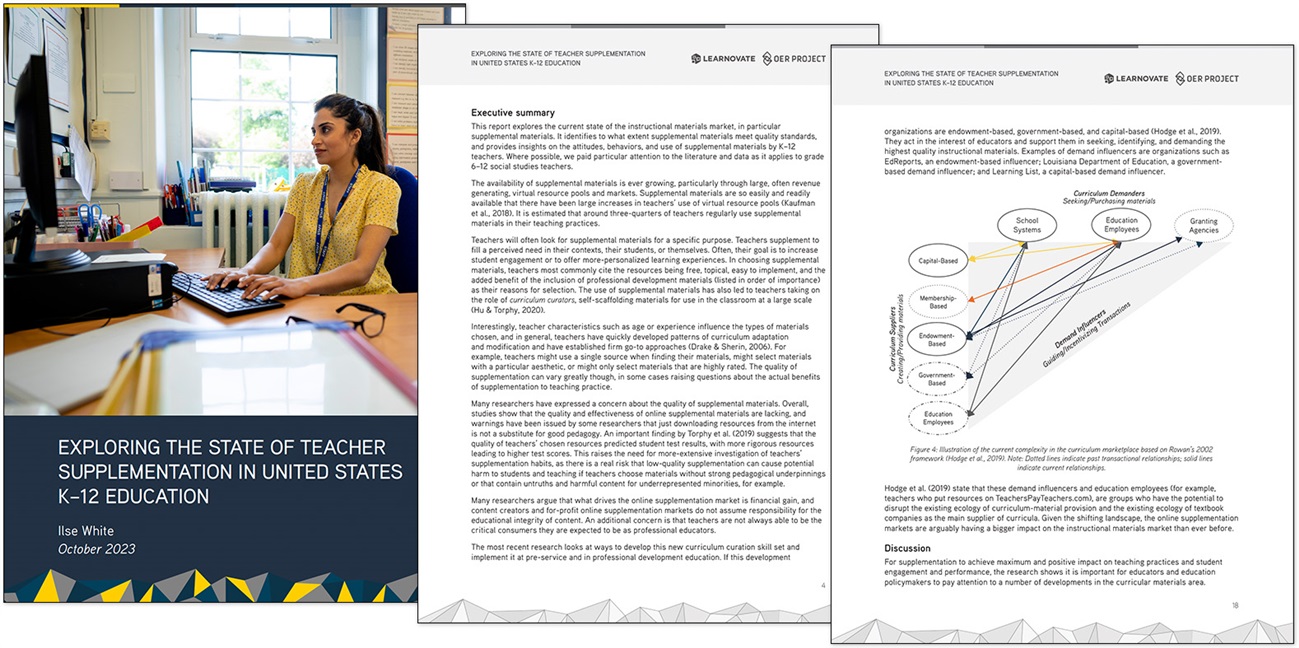By Rachel Phillips,
Senior Measurement & Learning Lead, OER Project
Research indicates that teachers are supplementing their primary curricula more than ever before. Eager to understand this growing trend in the profession, OER Project commissioned research from Learnovate at Trinity College in Dublin, Ireland. We also wanted to see how this trend is showing up in our community of OER Project teachers, so we ran a small research study of our own to see if their behaviors differ from the those of teachers at large, and to learn supplementation practices firsthand. Our small study, we were excited to learn, supports the findings from Learnovate and helps add some nuance to our understanding of how teachers find and use supplementary curriculum.

What did we learn about curriculum supplementation?
Supplemental materials are exploding online and through social media. It is easier than ever to search for and find materials—you can even use AI to help create them. And, with the increase of open educational resources, there is an ever-expanding curriculum marketplace that teachers can easily access. And accessing it they are! While publishers and content developers do their best to develop materials that are standards aligned, engaging, on-level, and relevant for all students, it’s nearly impossible to successfully meet all those criteria. Fortunately, teachers have the agency and ability to find materials that may better suit their students.
Teachers supplement for a lot of reasons: to fill gaps in curriculum, increase student engagement, add variety, or offer personalized learning experiences, for example. They tend to choose content that is free, topical, and easy to implement. Many teachers have a list of websites they regularly hit to find materials.
And while teachers report that they set out to look for materials to satisfy those reasons, what they select doesn’t always match their intended goals. They say it’s easy to get distracted by an engaging idea or a well formatted or “cute” lesson plan. Thankfully, it doesn’t take much to level up your (or your teachers’) supplementation game.
Based on what we’ve learned, we recommend keeping the following five questions in mind when you’re searching for high-quality supplemental instructional materials:
- Does this help achieve the goal I set out to meet? For example, if you’re looking for standards alignment, double check that the material does align (even if the content source says it is, make sure it’s the actual alignment you’re after).
- Is this a trusted website or author?
- Will this be engaging for my students?
- Is this culturally sensitive and safe to use in my classroom?
- Does this lesson have substance? Remember: Don’t judge a lesson plan by how good it looks.
We support curriculum supplementation and see it as an extension of supporting teachers on the ground. No matter how outstanding a curriculum is, it’s unreasonable to think that it will support all students all the time. So, whether it’s a teacher coming to grab a few OER Project materials, or an OER Project teacher looking for outside materials, we want to help set up them—and their students—for success. Teachers might not be expert curriculum curators right out of the gate, but if they think through these questions as part of the selection process, they’ll get there in no time.
About the author: Rachel Phillips, PhD, is a learning scientist who leads research and evaluation efforts for OER Project, and also develops curriculum for their courses. She is elementary certified, has taught in K–12 schools, and currently serves as an adjunct professor for graduate courses in American University’s School of Education. Rachel was formerly Director of Research and Evaluation at Code.org, faculty at the University of Washington, and program director for National Science Foundation-funded research. Her work focuses on the intersections of learning sciences and equity in formal educational spaces.
Cover image: A teacher discussing the day’s lesson with students. © Maskot / Getty Images.
 For full access to all OER Project resources AND our amazing teacher community,
For full access to all OER Project resources AND our amazing teacher community, 
